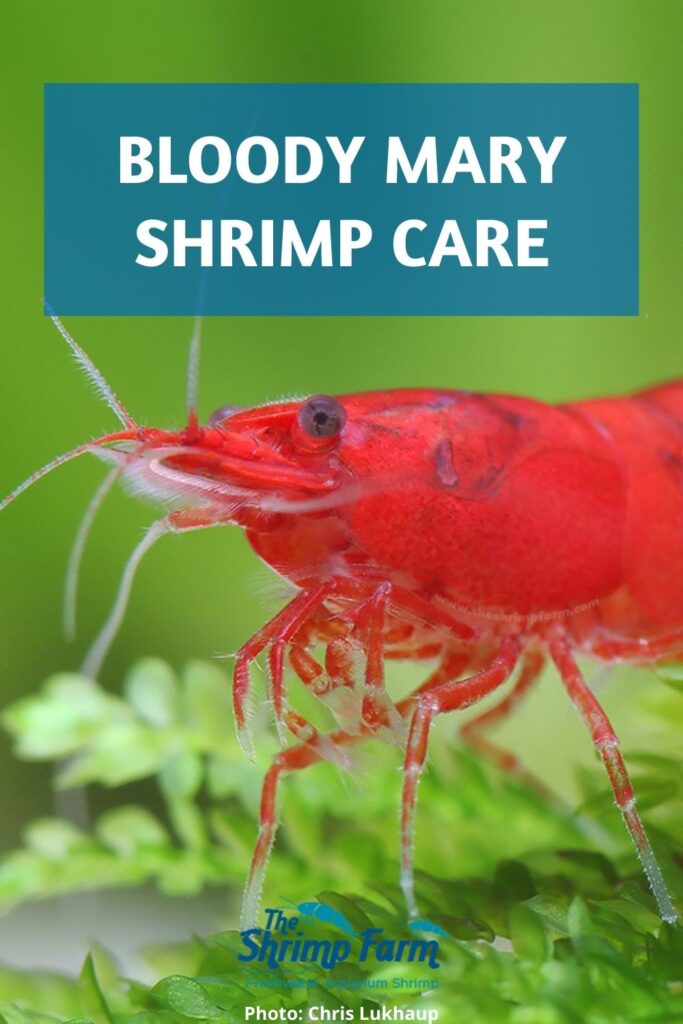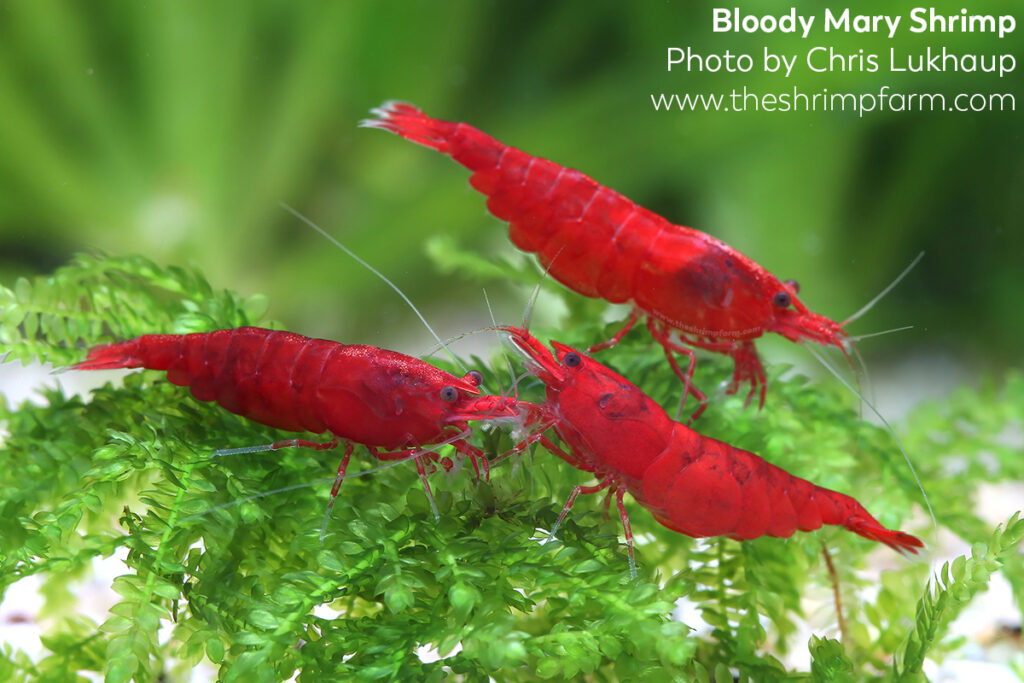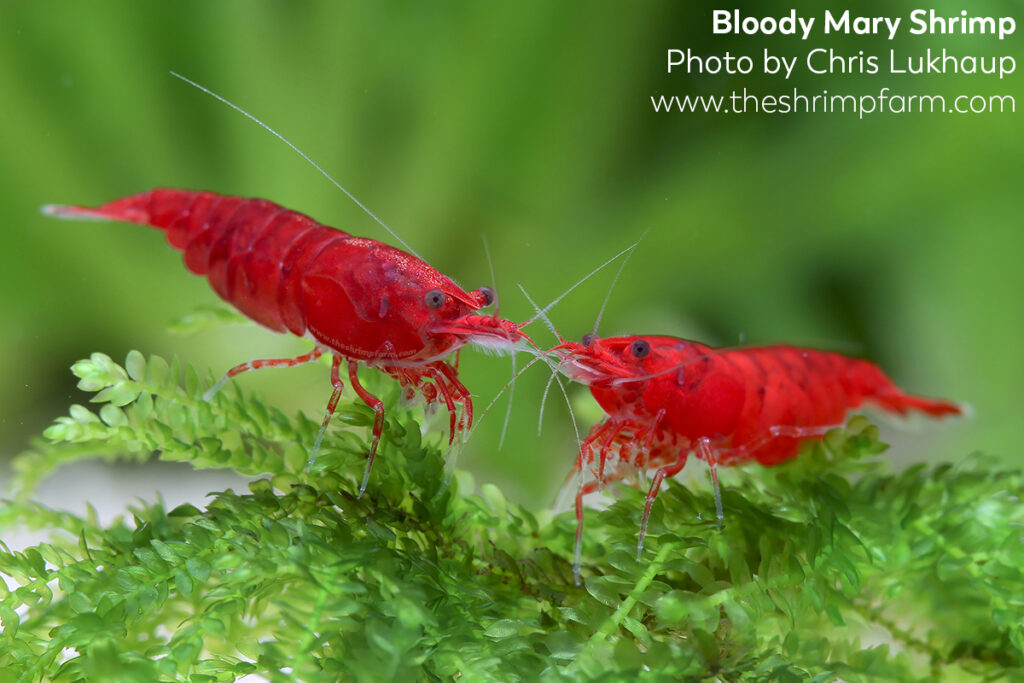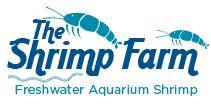Bloody Mary shrimp (Neocaridina davidi 'Bloody Mary') | Care & info
Looking for a red dwarf shrimp to add to your aquarium? Do red cherry shrimp just not quite cut it? Worry not! We've got just the solution for you. Meet the Bloody Mary shrimp: a Neocaridina davidi variety characterized by its extremely intense red coloration.
Keep reading for everything you need to know about Bloody Mary shrimp and how to keep them in your own aquarium!
| Scientific name | Neocaridina davidi 'Bloody Mary' |
| Common name | Bloody Mary shrimp |
| Difficulty level | Easy |
| Origin | China |
Table of Contents
Bloody Mary shrimp appearance
As mentioned in the intro, Bloody Mary shrimp are strikingly red. This appears to be due to the fact that unlike in regular red cherries, it's not their exoskeleton that contains their color. Instead, they actually sport a clear exoskeleton, and it's their flesh that's red. Truly the deepest red you can find within the Neocaridina davidi species!
Other than their color, Bloody Mary shrimp are mostly just normal dwarf shrimp. They grow to a maximum size of about 1.2", with the males staying smaller than the females. We've seen Bloody Maries that sport a shorter rostrum ('nose') than other Neos, but it seems this is not necessarily the norm.
Setting up a Bloody Mary shrimp aquarium
Requirements
The great thing about Bloody Mary shrimp is that they've got all that color, but the same Neocaridina care requirements. This means they're not overly fussy and should actually work absolutely fine even for the beginning dwarf shrimp enthusiast.
Your Bloody Mary shrimp will need an aquarium of at least 5 gallons, although 10 is a better place to start for beginners, as larger tanks are easier to keep stable. The aquarium should always be filtered and fully cycled before you introduce any livestock, or you risk your shrimps' lives. A heater is handy if the ambient temperature isn't stable, because dwarf shrimp don't react well to sudden fluctuations.
We usually use a dark substrate for our shrimp to really make their beautiful colors pop. A few live plants are great for adding hiding places and allowing yummy biofilm (a shrimp's favorite food) to grow. It's also always a good idea to add some shrimp tubes, leaf litter and/or wood. It sounds counterintuitive, but you'll actually see your shrimp more if they know they're able to hide when they want to.
Water parameters
You should almost always be able to keep Bloody Mary shrimp in tap water. They can handle a wide range of water parameters as long as the water is properly conditioned to remove chlorine/chloramine. Just make sure the cycle is solid: ammonia and nitrite should be at 0 at all times and nitrates ideally below 10.
Test regularly using your liquid water test kit and do weekly small water changes to keep the water quality high.
pH: 6.2-8.0
Temperature: 65-80 °F
Hardness: 5-12
Total Dissolved Solids: 150-250
Tankmates
For dwarf shrimp, your choices in tankmates usually mainly depend on how precious they are to you. The more expensive ones you'll want to keep alone, as there are almost no fish out there that will pass up the chance to snag some baby shrimp. The cheaper ones, especially those that breed very quickly, give you some more options.
Bloody Maries fall somewhere in the middle: they can be a little pricey, but they breed quickly. You could go for microfish tankmates without the population being decimated. If you'd rather not, then you could always combine them with other shrimp, as long as they're not Neocaridina (they would interbreed). Amano shrimp and Crystal Reds would make good options. The same goes for aquarium snails, which are 100% peaceful.
Bloody Mary shrimp diet
Bloody Maries eat the same as any dwarf shrimp: detritus. They're omnivores that will gladly consume anything they come across on the aquarium floor. This includes fish food, dead plant bits, biofilm, algae and much more. We recommend supplemental feedings at least once a day, although it's fine to skip days every so often.
You can use a high-quality shrimp food as a staple and add variety with pretty much anything you can think of. Blanched veggies, (frozen) fish food, seaweed sheets (nori)... even Indian almond leaves are gobbled up as they decay!
Breeding Bloody Mary shrimp
As with other Neocaridina davidi varieties, breeding Bloody Mary shrimp should be a breeze. In fact, it doesn't require any intervention on your part! You're just there to keep the water quality high and the shrimp well-fed. They do the rest.
Dwarf shrimp mature and begin to breed at 2-3 months of age. The female will develop a yellow spot behind the head, called the saddle. After breeding, the eggs contained in the saddle, now fertilized, will be moved to the back legs (swimmerets). The female keeps them here for about 30 days, fanning and cleaning them diligently, until tiny baby shrimp hatch.
The babies will strike out on their own immediately. They'll try to stay hidden until they're a bit larger, but they can fend for themselves and find their own food just fine. They begin coloring up nicely within a few weeks.
Frequently asked questions
What is the difference between red cherry shrimp and Bloody Mary shrimp?
That is an understandable question! Grade AA cherry shrimp (the most intense color variety in the cherry group) and Bloody Maries can be pretty similar in looks. As mentioned in the section on appearance, though, the difference is in where the color is located.
In cherry shrimp, it's their exoskeleton that carries the red coloration. In Bloody Mary shrimp, however, it's on the inside: the actual body tissue. Additionally, Bloody Maries will often sport a shorter rostrum than their cherry cousins.
Did you know? Bloody Maries and cherry shrimp are by no means the only red shrimp. Have a look at our list of red aquarium shrimp to discover them all!
Buying Bloody Mary shrimp
You may have to search a bit if you're interested in buying Bloody Mary shrimp. They're not as common as red cherries, but you should be able to find them in some online stores. Although they can cost a little more, their coloration more than makes up for that!



 Shrimp
Shrimp Fish
Fish Crab &
Crab & Plants
Plants Foods
Foods Snails
Snails


